Dogs
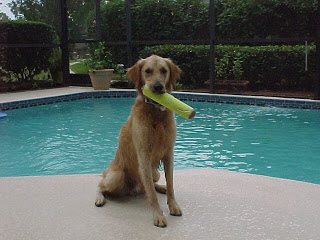
After reading a blog post at The Happy Wag, a Roanoke, Virginia pet blog, I learned about Stormy, who hasn't yet mastered the art of Fetch. This post is dedicated to Stormy and all of the rest of his canine cousins out there who would love to learn to retrieve and return a toy to their human best friends.
Fetch is an excellent way to establish your bond and leadership, while building discipline and trust with your dog. A mental challenge is a great way to add to the physical challenge of retrieving the ball or other fetch toy. Learning to bring it back to you, drop it at your feet, and wait patiently for another toss, takes practice. Each of these tasks is a separate skill, and each must be patiently taught separately, before being strung together for a Fetch game. So be patient, Pack Leader, a truly great game of Fetch is well worth the effort of learning it the right way, and much less frustrating for you and your dog.
I highly recommend that all dogs who are able, learn to fetch and return a ball or other toy. The benefits go far beyond the fun factor, not the least of which is that it goes a long way toward establishing you as the Pack Leader. Let's get started:
You may have read the title and wondered how many lessons there can possibly be in a "simple" game of Fetch. Simple for you, maybe. But stringing skills together for a dog requires teaching each one by one, at first. Here are the steps we'll learn in the sequence.
Skills Required for the Ultimate Game of Fetch:
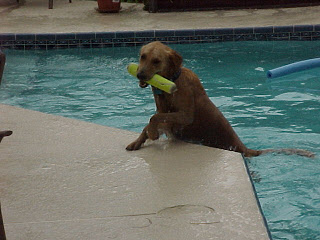
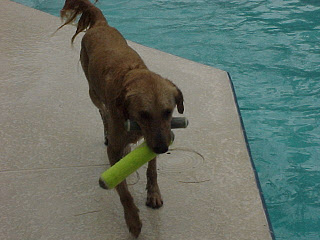

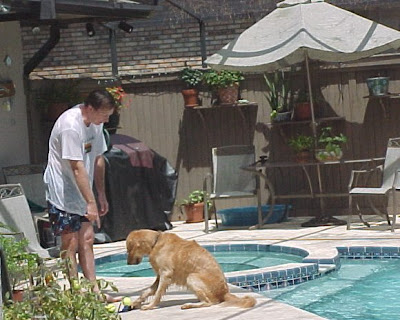
- Weekly Wag #13: Extra Credit Fetch!
by Carrie Boyko, CEB © All Things Dog Blog Tanner Snags Orbee Today's topics are for you Fetch fanatics out there like Tanner. I've got some fun games you can use to make the game a little more brain work for your dog: © All Things Dog Blog...
- Weekly Wag #11: Stringing Skills For Fetch
by Carrie Boyko, CEB © All Things Dog Blog Tanner Demonstrates Sit and Stay for My DaughterWe're on a roll now...on our way to that elusive game of Fetch that many of us dream of. This week let's work on starting to string skills together....
- Weekly Wag #8: Preparing For Fetch Training
by Carrie Boyko, CEB © B Boyko Point and Drop! © C Boyko Good Drop It, Tanner!When Tanner joined our family I was ecstatic. I didn't care that he had a knobby occipital lobe or was tall and lanky for a Golden Retriever. If anything, these qualities...
- Teaching Your Dog To Fetch
By Ruthie Bently You can teach your dog to fetch a newspaper, Frisbee, beer, a ball, even an egg. You can teach your dog to fetch (or retrieve) anything that is small enough for them to get a secure grip on, pick up and bring back to you. Teaching your...
- Dog Games - Top 5 Games That Will Tire Your Dog Out
Playing dog games with your canine pet provides your beloved with his much needed physical and mental stimulation. This also gives you the benefit of reinforcing his obedience training in a fun way as you establish a deeper relationship with him.However,...
Dogs
Teaching Your Dog to Fetch
© photo copyright Carrie Boyko
Please Play Fetch with Me
After reading a blog post at The Happy Wag, a Roanoke, Virginia pet blog, I learned about Stormy, who hasn't yet mastered the art of Fetch. This post is dedicated to Stormy and all of the rest of his canine cousins out there who would love to learn to retrieve and return a toy to their human best friends.
Fetch is an excellent way to establish your bond and leadership, while building discipline and trust with your dog. A mental challenge is a great way to add to the physical challenge of retrieving the ball or other fetch toy. Learning to bring it back to you, drop it at your feet, and wait patiently for another toss, takes practice. Each of these tasks is a separate skill, and each must be patiently taught separately, before being strung together for a Fetch game. So be patient, Pack Leader, a truly great game of Fetch is well worth the effort of learning it the right way, and much less frustrating for you and your dog.
I highly recommend that all dogs who are able, learn to fetch and return a ball or other toy. The benefits go far beyond the fun factor, not the least of which is that it goes a long way toward establishing you as the Pack Leader. Let's get started:
You may have read the title and wondered how many lessons there can possibly be in a "simple" game of Fetch. Simple for you, maybe. But stringing skills together for a dog requires teaching each one by one, at first. Here are the steps we'll learn in the sequence.
Skills Required for the Ultimate Game of Fetch:
- Sit
- Stay
- Come
- Drop It
- Leave It
- Fetch
- Your dog must master a "Sit, Stay". Remember to use plenty of calm verbal praise.
- Step away from your dog and remind him to stay. Don't throw until he is tuned in and attentive to you.
- Maintaining eye contact, the owner throws the toy and gives the Fetch command. The dog usually understands that this means to chase the flying toy. Not much skill involved in this action, except to leap over any obstacles or off the side of the pool:
© photo copyright Carrie Boyko
Tanner Leaps to Fetch
- If he runs toward the toy, give verbal praise and encouragement. If he picks up the toy, get even more boisterous with your praise. Begin calling him to you. If this is unsuccessful, extra training in "Come when called" is needed.
© photo copyright Carrie Boyko
Tanner Collects His Prize
and Heads Back to Return It
© photo copyright Carrie Boyko
I'm Almost There...
Can We Do It Again?
- Never, ever discipline a dog when he does not come. Would you come if you were spanked when you came slowly? No, of course not. Always praise your dog when he comes. Use more vigorous praise, petting, treats and other affection when his come is more immediate and successful. Ideally, your dog should come straight to you and sit. This should be your ultimate goal.
© photo copyright Carrie Boyko
Tanner Returns the Fetch Toy
for Another Throw
© photo copyright Carrie Boyko
Sit, Tanner
- The next goal is to get the dog to return the toy and drop it at your feet. Praise and a treat are earned when this occurs. If you are successful in getting the dog to come back to you, try this. Ask him to sit. Step toward him and give the drop it command while looking down over him. This establishes your dominance and will usually be respected, if you are seen by him as the leader of the pack. Be prepared to practice this again and again, as some dogs may have difficultly giving up the toy. If they refuse, do not try to forcibly remove it from their mouths. Turn your back and end the game. When he drops the toy, step on it and ask him to leave it. Put him in a sit and place the toy up on a shelf again. End of game. Lesson: Drop it or I end the game. He'll catch on fast to this, if you are consistent.

© photo copyright Carrie Boyko
Drop It. Good Boy, Tanner!
Drop It. Good Boy, Tanner!
- Eventually, Fetch games can move into advanced mental games like: (1) Start with the "Leave it" command, that asks dog to stay until you give the Fetch command. Throw the toy and have him leave it...a second or two at first, and then with increasing length. As the dog gets better, you can require him to wait longer periods before giving the Fetch command. This is a good mental challenge for him. (2) Give each Fetch toy a name. Practice the game using the name, so the dog learns them. Multiple toys can then be thrown. The dog is asked to Fetch the correct toy by name. This game is lots of fun when your dog has an audience. He gets a chance to show off; He knows the names of his toys! (3) When your dog really gets good at advanced game #2, you can work on this game: Show him 3 toys. Tell him to Leave It when showing 2 of them. Throw all 3 and then ask him to Fetch the last one. This will take lots of practice, but when he gets it, he'll beam with pride. Be sure to use lots of praise, pats and even treats to encourage these skills, until your dog is performing them "for the love of the game". (4) Finally, many dogs enjoy trying to catch the fetch toy before it hits the ground or the water. This is a great challenge and loads of fun for the dog who is motivated to try this. Tanner isn't terribly talented at this game, but occasionally he gets lucky:

© photo copyright Carrie Boyko
I Caught It Mom!
- I often allow Tanner one "Take It" at the end of a Fetch game. I extend the toy in my hand and he proudly takes it from me and basks in the sun with it. This is one of his favorite rewards--being able to be in charge of the toy, even if only for a few minutes.
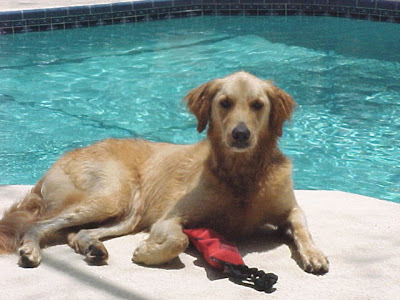
Tanner Relaxes after a
Game of Fetch with "Red"
- Be sure to keep these opportunities short. Ask your dog to drop it and leave it and return the toy to its storage place for the next game. This is ample motivation for him to look forward to it again. You're on the right track.
- Weekly Wag #13: Extra Credit Fetch!
by Carrie Boyko, CEB © All Things Dog Blog Tanner Snags Orbee Today's topics are for you Fetch fanatics out there like Tanner. I've got some fun games you can use to make the game a little more brain work for your dog: © All Things Dog Blog...
- Weekly Wag #11: Stringing Skills For Fetch
by Carrie Boyko, CEB © All Things Dog Blog Tanner Demonstrates Sit and Stay for My DaughterWe're on a roll now...on our way to that elusive game of Fetch that many of us dream of. This week let's work on starting to string skills together....
- Weekly Wag #8: Preparing For Fetch Training
by Carrie Boyko, CEB © B Boyko Point and Drop! © C Boyko Good Drop It, Tanner!When Tanner joined our family I was ecstatic. I didn't care that he had a knobby occipital lobe or was tall and lanky for a Golden Retriever. If anything, these qualities...
- Teaching Your Dog To Fetch
By Ruthie Bently You can teach your dog to fetch a newspaper, Frisbee, beer, a ball, even an egg. You can teach your dog to fetch (or retrieve) anything that is small enough for them to get a secure grip on, pick up and bring back to you. Teaching your...
- Dog Games - Top 5 Games That Will Tire Your Dog Out
Playing dog games with your canine pet provides your beloved with his much needed physical and mental stimulation. This also gives you the benefit of reinforcing his obedience training in a fun way as you establish a deeper relationship with him.However,...
